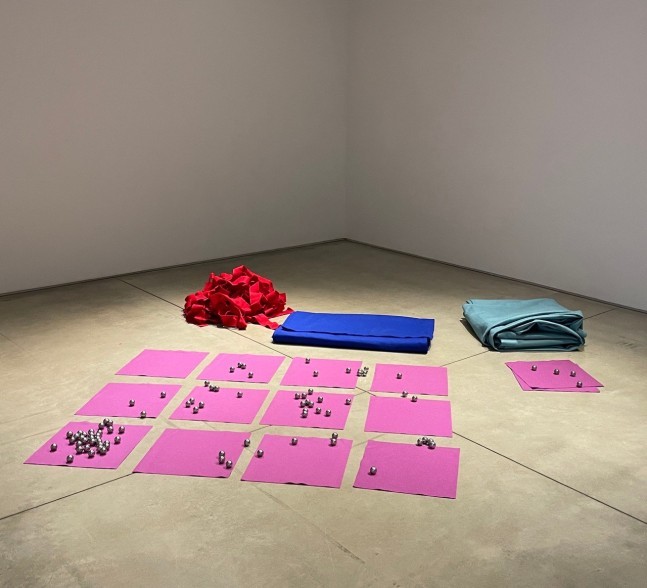
BARRY LE VA
Marc Selwyn Fine Art is delighted to present a solo exhibition of three historical works by Barry Le Va.
Renowned as a leading figure of Postminimalism alongside peers Bruce Nauman, Richard Serra, Eva Hesse, and Robert Smithson, among others, Barry Le Va’s art of the 1960s and 70s pushed the formal limits of sculpture as a medium. His practice intertwined concepts of relational space, order versus chaos, and his preoccupation with what remains as “evidence” after actions and events. A fan of Sherlock Holmes, Le Va often compared the interpretation of his sculptures to gathering evidence in a forensic investigation.
On view in the main gallery is Untitled (Chalk Inverse), 1969, one of his rarely exhibited powder dispersal works. Using the measurements of the entrance to the exhibition to delineate a square of negative space, the architecture of the gallery is then bisected linearly, resulting in a geometric figure formed with layers of white chalk. Le Va’s powder works elegantly distill the artist’s intention “to eliminate sculpture as a finished, totally resolved object…to eliminate a sense of wholeness and concentrate on parts, fragments, incomplete activities and structures.”
Le Va’s interest in confounding the viewer is also apparent in his felt works. In A - (Red, Green, Blue, Purple, Felt, Steel, Bought, Cut, Folded, Placed, Rolled), 1966, purple squares of felt are arranged in a grid-like formation, with additional square pieces haphazardly stacked, all amongst scattered steel marbles. A pile of red felt strips, a neatly folded blue felt roll, and a loosely folded green roll sit nearby. The title’s descriptive language is ultimately imprecise, however, making a complete reconstruction of its creation impossible.
In 1969 Le Va began to experiment with meat cleavers thrown or hacked into the wall and/or floor. As with his felt works, the cleaver sculptures can be interpreted as a series of clues to Le Va’s sequential movements, highlighting the work's performative qualities. Cleaved Corners 3, 1969 consists of six meat cleavers driven into the walls of a corner. His use of cleavers as evidence of these precise gestures – objects that are emblematic of aggression - reflects the violence, frustration, confusion, and random impulse that permeated the sociopolitical unrest of the era.
Le Va will be the subject of an upcoming retrospective at the Kunstmuseum, Liechtenstein in April of 2024. The show will then travel to the Museum Kurhaus Kleve, Germany, and the Fruitmarket Gallery, Edinburgh.
Originally trained as an architect, Barry Le Va (1941-2021) was born in Long Beach, CA, and attended California State University, Long Beach. However, his determination to “create work on my own terms” soon led him to the art department. He transferred to the Los Angeles College of Art and Design then moved on to LA’s Otis Art Institute, where he received a BA and an MFA in 1964 and 1967 respectively. Shortly after, he had his first solo exhibitions at the Minneapolis Institute of Art and the Walker Art Center. He received a Guggenheim Fellowship in 1974 followed by a National Endowment for the Arts Fellowship in 1976. By the late 1970s, Le Va relocated to New York City where he lived and worked for the rest of his life.
Following his first solo exhibition in 1969 at the Walker Art Center, Minneapolis, his work was included in landmark presentations including Anti-Illusion: Procedures/Materials in 1969 at the Whitney Museum of American Art and Information in 1970 at the Museum of Modern Art. Le Va has also participated in Documenta (1972, 1977, and 1982) and the Whitney Annual and Biennial exhibitions (1971, 1977, and 1995). Major surveys of his work have taken place at the New Museum, New York (1979); Carnegie Mellon Art Gallery, Pittsburgh (1988), (which traveled to Orange County Museum of Art, Newport Beach, 1989; High Museum of Art, Atlanta, 1989; Neuberger Museum of Art, New York 1990); Institute of Contemporary Art, Philadelphia (2005); and Serralves Museum, Porto, Portugal (2006). In the last decade, Le Va’s work has been included in important exhibitions at Museum für Moderne Kunst Frankfurt (2020); MoMA PS1, New York (2015–16); Yale University School of Art (2015); Dallas Museum of Art (2015); Castello di Rivoli Museum of Contemporary Art, Italy (2011); and Peggy Guggenheim Collection, Venice, Italy (2011), among others. More recently, Le Va was the subject of a retrospective at Dia: Beacon from 2019-2021.
Le Va’s works can be found in the permanent collections of the Art Institute of Chicago; The Museum of Modern Art, New York; The National Gallery of Art, Washington DC; The Morgan Library & Museum, New York; Whitney Museum of American Art, New York; Walker Art Center, Minneapolis; Los Angeles County Museum of Art; Yale University Art Gallery, New Haven; Dallas Museum of Art; Denver Art Museum; Centre Pompidou, Paris; mumok, Vienna; Museum Ludwig, Cologne; Museu Serralves, Porto; among others.